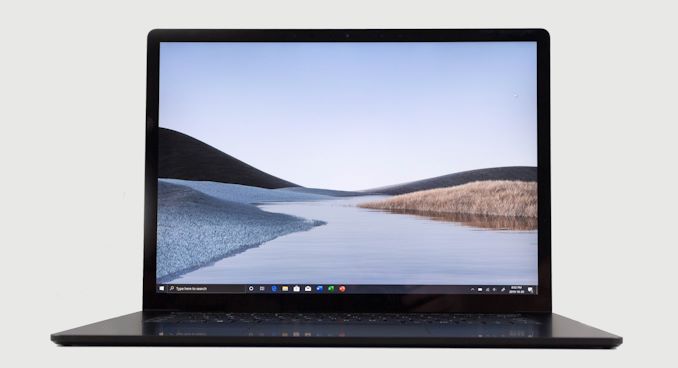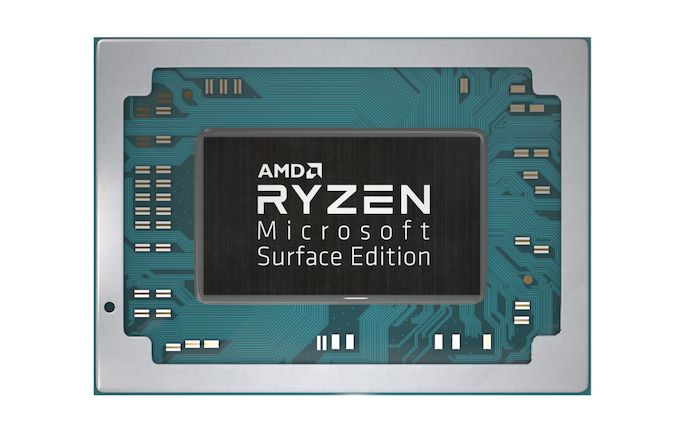The Microsoft Surface Laptop 3 Showdown: AMD's Ryzen Picasso vs. Intel's Ice Lake
by Brett Howse & Andrei Frumusanu on December 13, 2019 8:30 AM ESTFinal Words
Two laptops. Two platforms. It is rare to have a chance to see a manufacturer offer such equal footing to both AMD and Intel by outfitting a premium laptop with processors from both. It represents a rare opportunity to get to test the latest processors from AMD and Intel in a laptop in such an apples-to-apples fashion.
In the laptop space, design, cooling, and a manufacturers requirements can play a big part in how a particular chip performs, thanks to adjustable power level settings, surface temperature adjustments, and more. We have seen the lowest tier CPU outperform the highest tier CPU just by the virtue of a better cooling system, so to have processors from AMD and Intel, both of which launched in 2019, in the same chassis is a wonderful opportunity.
There aren’t too many ways to sugar coat the results of this showdown though. AMD’s Picasso platform, featuring its Zen+ cores and coupled with a Vega iGPU, has been a tremendous improvement for AMD. But Intel’s Ice Lake platform runs circles around it. Sunny Cove cores coupled with the larger Gen 11 graphics have proven to be too much to handle.
On the CPU side, no one should be too surprised by the results. We've already seen on the desktop that AMD’s Zen+ cores were competitive, but slightly slower than the previous Skylake platform; and the new Sunny Cove microarchitecture from Intel is a big step forward in terms of IPC for Intel. On purely CPU based tasks, Ice Lake really stretched its legs, and despite this being a 3.9 GHz chip, in single-threaded SPEC 2017, it managed to come very close to a 5.0 GHz Core i9-9900K with a massively higher TDP. Zen+ is outclassed here, and that showed in the benchmark results, and especially in the benchmark time. On our 8-thread SPEC 2017 run, the Ice Lake platform finished just a hair over two hours ahead of Picasso.
But things fare better for AMD on the GPU side of matters. Even though Intel has certainly closed the gap with Ice Lake's iGPU, AMD seems to continue to hold an advantage, especially on the 11 Compute Unit Ryzen Surface Edition processor found in the Surface Laptop 3. Intel has dedicated a lot more die area to the GPU and the results put them almost on equal footing with the Vega based GPU on Picasso. On the more complex GPU tasks, AMD tends to have a slight lead, and AMD’s low-level driver support also seems to benefit them on DirectX 12 based tasks. But, Ice Lake’s GPU is helped by the much quicker CPU it is coupled to, so depending on the specific test it can be even quicker.
Ice Lake does all of this with much better power efficiency as well. Overall battery life is quite a bit longer, and idle power draw is notably lower as well. Case in point: at minimum screen brightness, the Ice Lake system was pretty much only sipping power, drawing around 1.7 Watts, versus the 3.0 Watts for the AMD system.
It was fantastic to see AMD get a design win in a premium laptop this year, and the Surface Laptop 3 is going to turn a lot of heads over the next year. AMD has long needed a top-tier partner to really help its mobile efforts shine, and they now have that strong partner in Microsoft, with the two of them in a great place to make things even better for future designs. Overall AMD has made tremendous gains in their laptop chips with the Ryzen launch, but the company has been focusing more on the desktop and server space, especially with the Zen 2 launch earlier this year. For AMD, the move to Zen 2 in the laptop space can’t come soon enough, and will hopefully bring much closer power parity to Intel’s offerings as well.
Meanwhile for Intel, Ice Lake has been years in the making, and, after a long delay, it is finally here. After digging into the platform in-depth, it’s clear that Ice Lake is an incredibly strong offering from Intel. The CPU performance gains are significant, particularly because they were made in the face of a CPU frequency deficit. But the biggest gains were on the GPU side, where Intel’s Gen 11 GT2 in its full 64 Execution Unit configuration is likely the biggest single increase in GPU performance since they started integrating GPUs. It pulls very close to AMD’s Vega, closing the gap in performance to almost zero.
2019 has been a big year in the laptop space, with both Intel and AMD bringing new tools to the game. 2020 should be just as exciting, and if we’re lucky, we’ll get another chance to do this all over again.













174 Comments
View All Comments
Fataliity - Friday, December 13, 2019 - link
I didn't notice that graph, your right. It's sad that the thermal throttling is so bad on Ice Lake. Look at how fast it hits 100c and has to lower its frequency to 2.5Ghz. If it could control its temps and didnt use so much power, it would be a beast of a chip.Fataliity - Friday, December 13, 2019 - link
Over 40 Watts at boost frequency! That's insane. more than the TDP of the product.Fataliity - Friday, December 13, 2019 - link
So for servers if scaling is pretty close, its using 5 watts per core at 2.5 GHZ. u can expect 56 Cores in a 280W TDP.At Epyc's TDP of 225W, you can fit 45 cores.
So if Ice Lake is aiming for 280W TDP and, 38? cores. You should be able to hit around 3 GHZ with TDP judging by graph of 30watts being pulled around 3GHZ. (Not counting memory controller etc.) with IPC boost the server part might be decent, albeit with alot less cores.
Fataliity - Friday, December 13, 2019 - link
And Lastly, look at that graph for TDP during boost.https://images.anandtech.com/doci/15213/CinbenchR2...
You will never see Ice Lake desktop product.
Compare the watt graph to Ryzen's wat graph below.
See the way the Ice Lake increases substantially wattage to pull boost clocks? It's probably already near the silicon limit judging by the graph. Like where they plot the voltage vs frequency, showing that the last few hundred mhz takes an insane amount of power. Ice Lake graph shows this in the 3 GHz
sorry no edit button.
Fataliity - Friday, December 13, 2019 - link
25Watts at 2.7-2.9 ghz. 47 watts at 3.7ghz.Brett Howse - Saturday, December 14, 2019 - link
That's how the Power Levels work. Processor gets extended boost level 2 for a certain amount of time. Please see here:https://www.anandtech.com/show/13544/why-intel-pro...
m53 - Sunday, December 15, 2019 - link
@Brett: Why feeding the troll? Just ignore Fataliity. I wish Anandtech has some moderation in the comment section against trolling and spamming.maroon1 - Friday, December 13, 2019 - link
Cpu performance and power effiency is much more important than slightly faster gpu than ryzen has. It is not like people buy these things to play games. And the difference is too small anyway. Ice lake wins in some gamesSo intel is better out of the two
ZoZo - Friday, December 13, 2019 - link
"despite this being a 3.9 GHz chip, in single-threaded SPEC 2017, it managed to come very close to a 5.0 GHz Core i9-9900K with a massively higher TDP"Could you please remind readers how long those benchmarks run? Because if it's less than 10 seconds, the TDP and better heat dissipation of desktops won't provide any benefits on single-threaded workloads and it's misleading to mention it.
In fact, I would really like a comparison of various laptop chips versus desktop chips, in scenarios that require prolonged CPU load, such as compiling the Linux kernel, rendering something, etc. Scenarios where the laptop chips will be undergo throttling and show their weakness or lack thereof compared to desktop chips. Not those 1-second benchmarks such as those that are in AIDA64.
extide - Friday, December 13, 2019 - link
They are pretty long -- they don't mention the runtime of the single thread tests specifically but they do mention the multi thread tests took 4-6 hours. The multi thread tests are the same as the ST ones, just running multiple (8) copies. (This is all talking about the SPEC benchmarks)